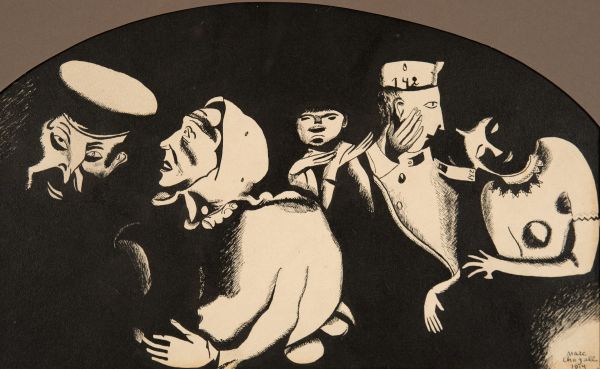|
|
The Date. 1914

Chagall Marc,
India ink on paper
18,5 х 29,5 (очерчен, полуовал)
Private collection, St.Petersburg
Annotation
The drawing The Date was published in the monograph The Art of Marc Chagall by Abram Efros and Yakov Tugendhold under the title Soldiers and Lovers (Moscow, 1918, p.43). The theme of separation and farewells to soldiers departing for the front is recurring in Chagall’s graphic works during wartime. These also include the composition held by the Russian Museum Collection por-traying the couple from the left side of The Date. Each character in the drawing, immersed in a universal human drama, reacts in a different way. With a distinctively sentimental and expressive style, the artist transmits a wide range of human emotions, from the ironic disdain at fate expressed by the man with a beard, and the desperation of the sharply profiled woman turned towards him, to the serene confidence in the future emanating from the girl’s smile.
Author's Biography
Chagall Marc
Chagall, Marc (Shagal, Mark Zakharovich)
1887, Vitebsk - 1985, St Paul de Vence (France)
Painter, graphic artist. Studied at the Yehuda Pen School in Vitebsk (1906), School of Drawing, Society for the Encouragement of the Arts (1907-08), Seidenberg''s studio, under Mstislav Dobuzhinsky and Leon Bakst at the Elizaveta Zvantseva School of Drawing and Painting (1908-09) and in private studios in Paris (1910-14). Contributed to the exhibitions of the World of Art (1912), Donkey''s Tail (1912), Salon des Independants (1912-14) and Jack of Diamonds (1916). Lived in Vitebsk and Petrograd (from 1915), director of the Vitebsk School of Art. Moved to Moscow (1920) and worked for the Jewish Chamber Theatre. Illustrated Nikolai Gogol''s Dead Souls and La Fontaine''s frobtes for Ambroise Vollard. Designed the sets and costumes for a production of Igor Stravinsky''s ballet The Firebird (1945). Retrospective exhibition at the Museum of Modern An in New York (1946). Lived in Paris (from 1923), USA (from 1941) and St Paul de Vence (from 1950).

